Service Quality in Higher Education: Annotated Bibliography Report
VerifiedAdded on 2023/01/16
|10
|2405
|78
Annotated Bibliography
AI Summary
This assignment is an annotated bibliography focusing on service quality within the context of higher education. It includes five research studies published between 2014 and 2019, exploring various aspects of service quality and customer loyalty in the tourism and hospitality sectors, with relevance to higher education. The introduction sets the stage by highlighting the importance of customer loyalty for revenue generation and growth. Each annotated bibliography summarizes a specific article, delving into topics like machine learning in customer engagement, customer perceptions of innovativeness, the role of tour leaders, the integration of individualism and collectivism in spas, and the impact of green practices in coastal tourism. The conclusion synthesizes the findings, emphasizing the crucial role of customer retention and suggesting avenues for future research. The references section provides a list of all the sources used in the assignment.
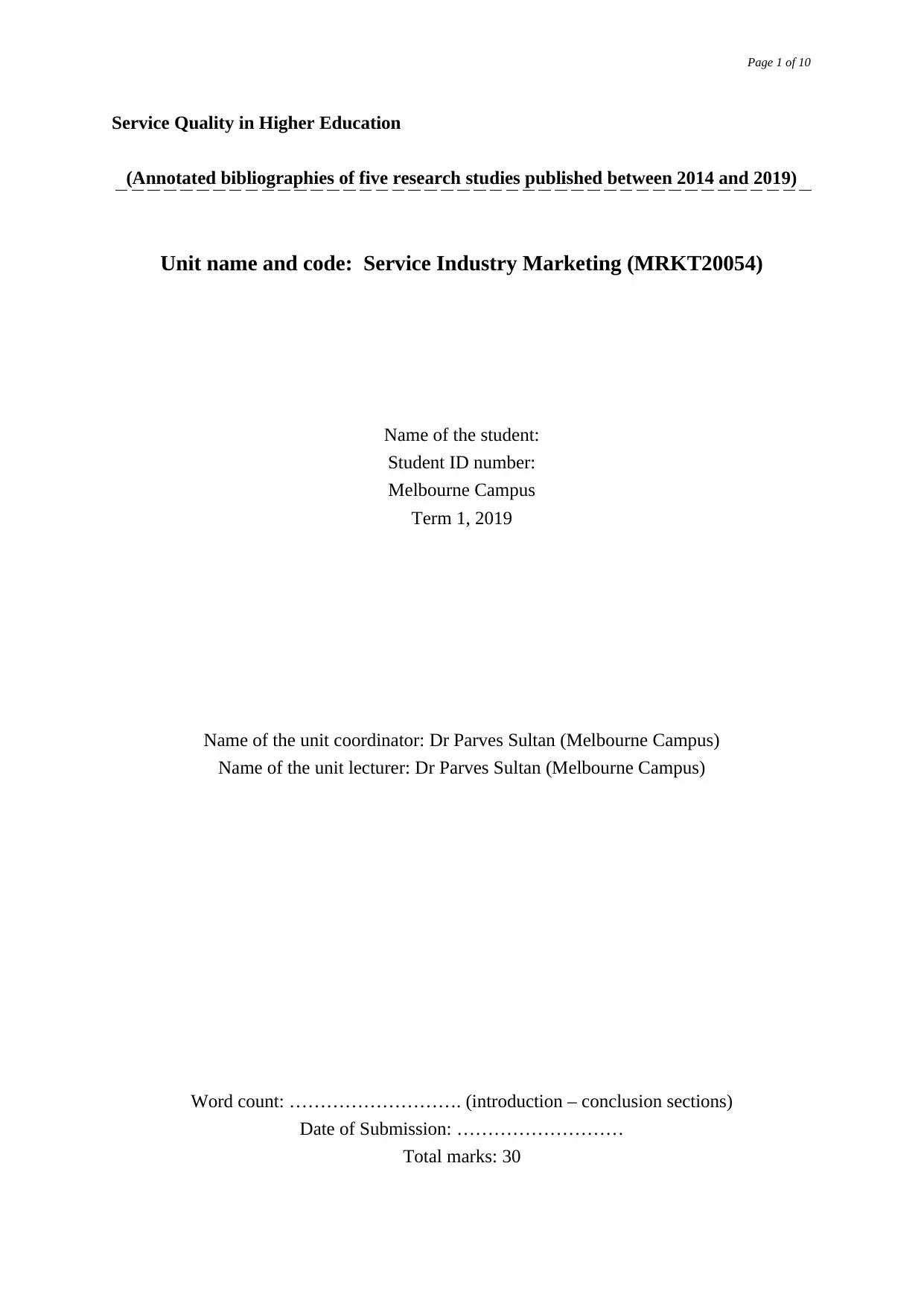
Page 1 of 10
Service Quality in Higher Education
(Annotated bibliographies of five research studies published between 2014 and 2019)
Unit name and code: Service Industry Marketing (MRKT20054)
Name of the student:
Student ID number:
Melbourne Campus
Term 1, 2019
Name of the unit coordinator: Dr Parves Sultan (Melbourne Campus)
Name of the unit lecturer: Dr Parves Sultan (Melbourne Campus)
Word count: ………………………. (introduction – conclusion sections)
Date of Submission: ………………………
Total marks: 30
Service Quality in Higher Education
(Annotated bibliographies of five research studies published between 2014 and 2019)
Unit name and code: Service Industry Marketing (MRKT20054)
Name of the student:
Student ID number:
Melbourne Campus
Term 1, 2019
Name of the unit coordinator: Dr Parves Sultan (Melbourne Campus)
Name of the unit lecturer: Dr Parves Sultan (Melbourne Campus)
Word count: ………………………. (introduction – conclusion sections)
Date of Submission: ………………………
Total marks: 30
Paraphrase This Document
Need a fresh take? Get an instant paraphrase of this document with our AI Paraphraser
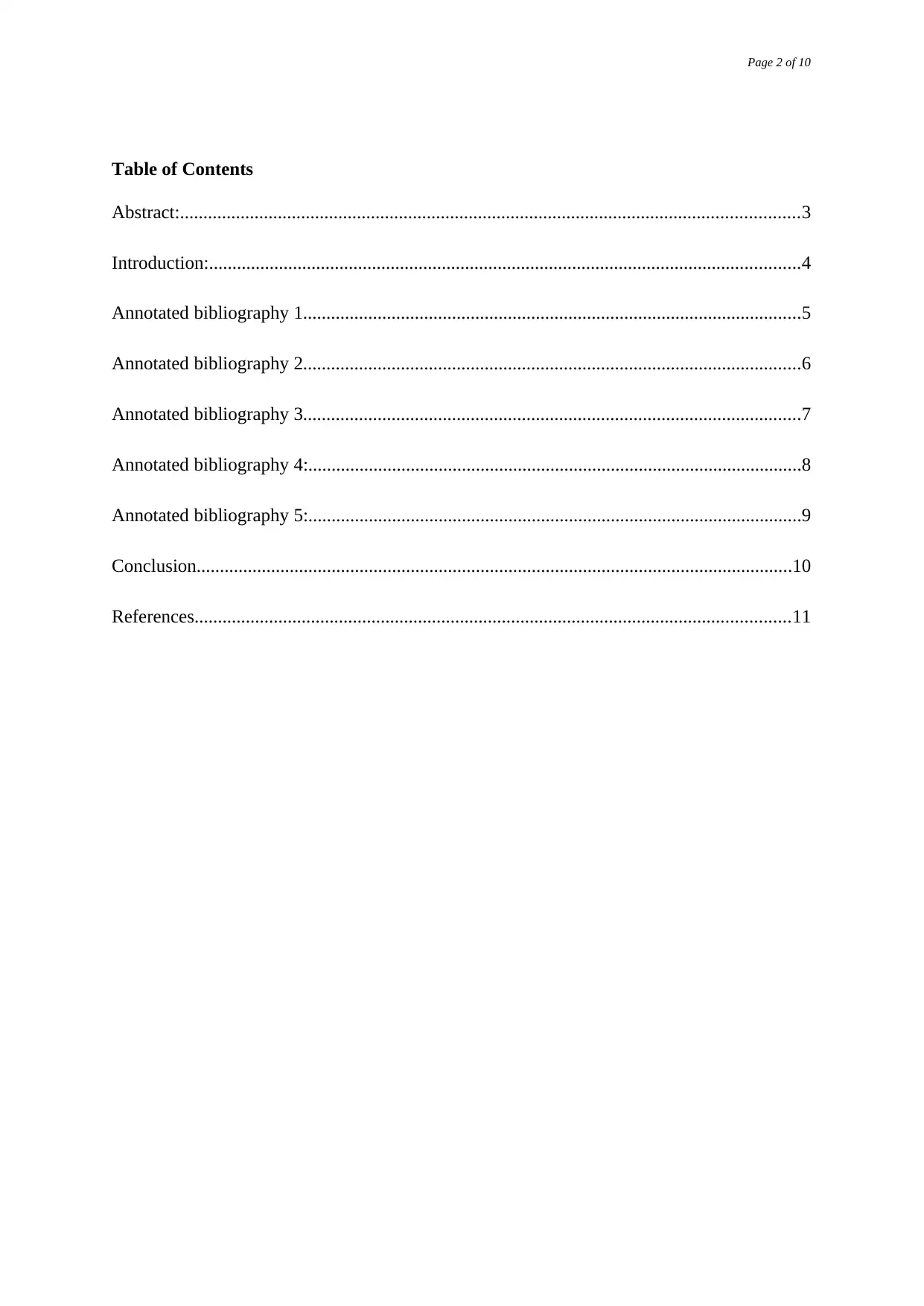
Page 2 of 10
Table of Contents
Abstract:.....................................................................................................................................3
Introduction:...............................................................................................................................4
Annotated bibliography 1...........................................................................................................5
Annotated bibliography 2...........................................................................................................6
Annotated bibliography 3...........................................................................................................7
Annotated bibliography 4:..........................................................................................................8
Annotated bibliography 5:..........................................................................................................9
Conclusion................................................................................................................................10
References................................................................................................................................11
Table of Contents
Abstract:.....................................................................................................................................3
Introduction:...............................................................................................................................4
Annotated bibliography 1...........................................................................................................5
Annotated bibliography 2...........................................................................................................6
Annotated bibliography 3...........................................................................................................7
Annotated bibliography 4:..........................................................................................................8
Annotated bibliography 5:..........................................................................................................9
Conclusion................................................................................................................................10
References................................................................................................................................11
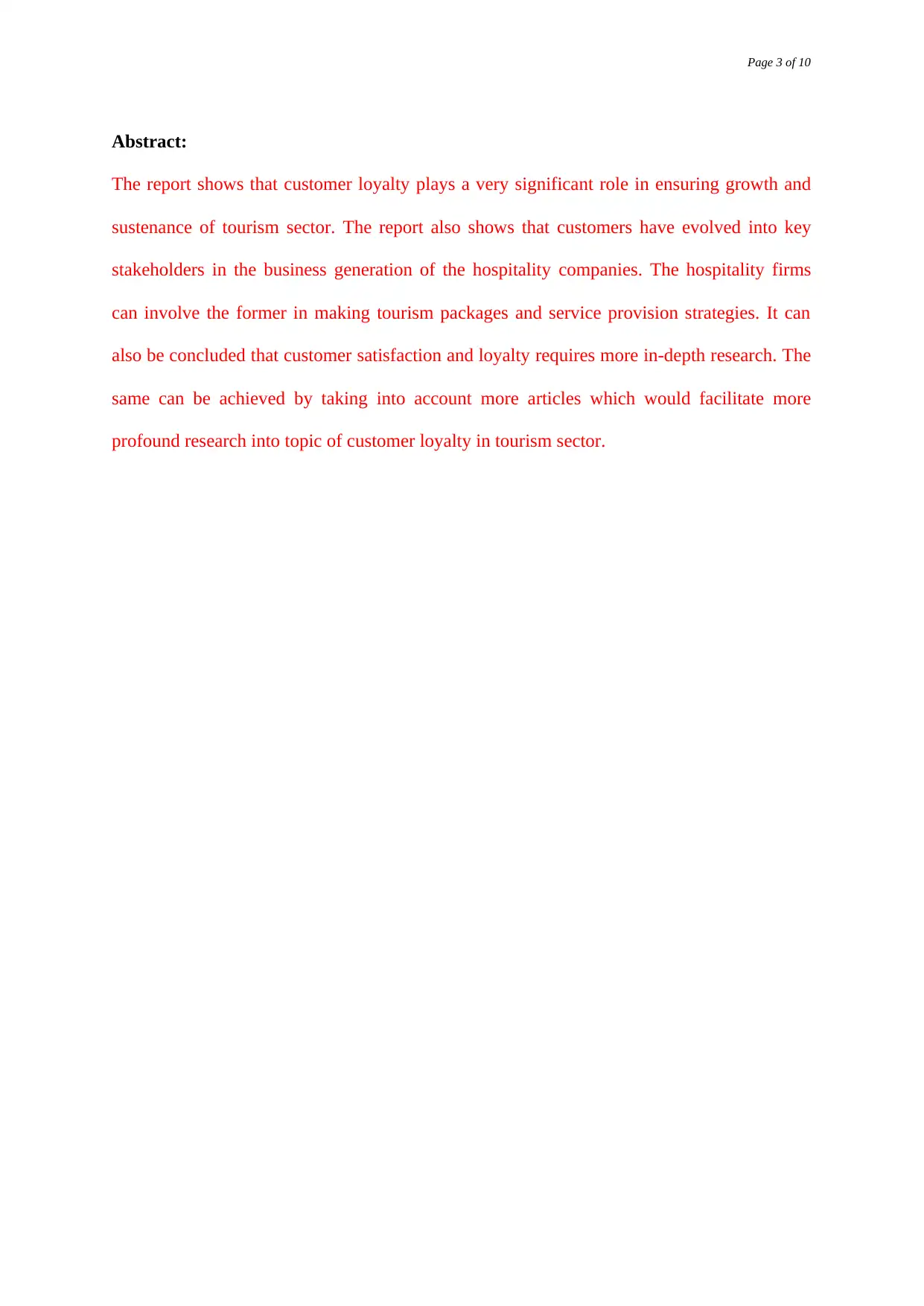
Page 3 of 10
Abstract:
The report shows that customer loyalty plays a very significant role in ensuring growth and
sustenance of tourism sector. The report also shows that customers have evolved into key
stakeholders in the business generation of the hospitality companies. The hospitality firms
can involve the former in making tourism packages and service provision strategies. It can
also be concluded that customer satisfaction and loyalty requires more in-depth research. The
same can be achieved by taking into account more articles which would facilitate more
profound research into topic of customer loyalty in tourism sector.
Abstract:
The report shows that customer loyalty plays a very significant role in ensuring growth and
sustenance of tourism sector. The report also shows that customers have evolved into key
stakeholders in the business generation of the hospitality companies. The hospitality firms
can involve the former in making tourism packages and service provision strategies. It can
also be concluded that customer satisfaction and loyalty requires more in-depth research. The
same can be achieved by taking into account more articles which would facilitate more
profound research into topic of customer loyalty in tourism sector.
⊘ This is a preview!⊘
Do you want full access?
Subscribe today to unlock all pages.

Trusted by 1+ million students worldwide
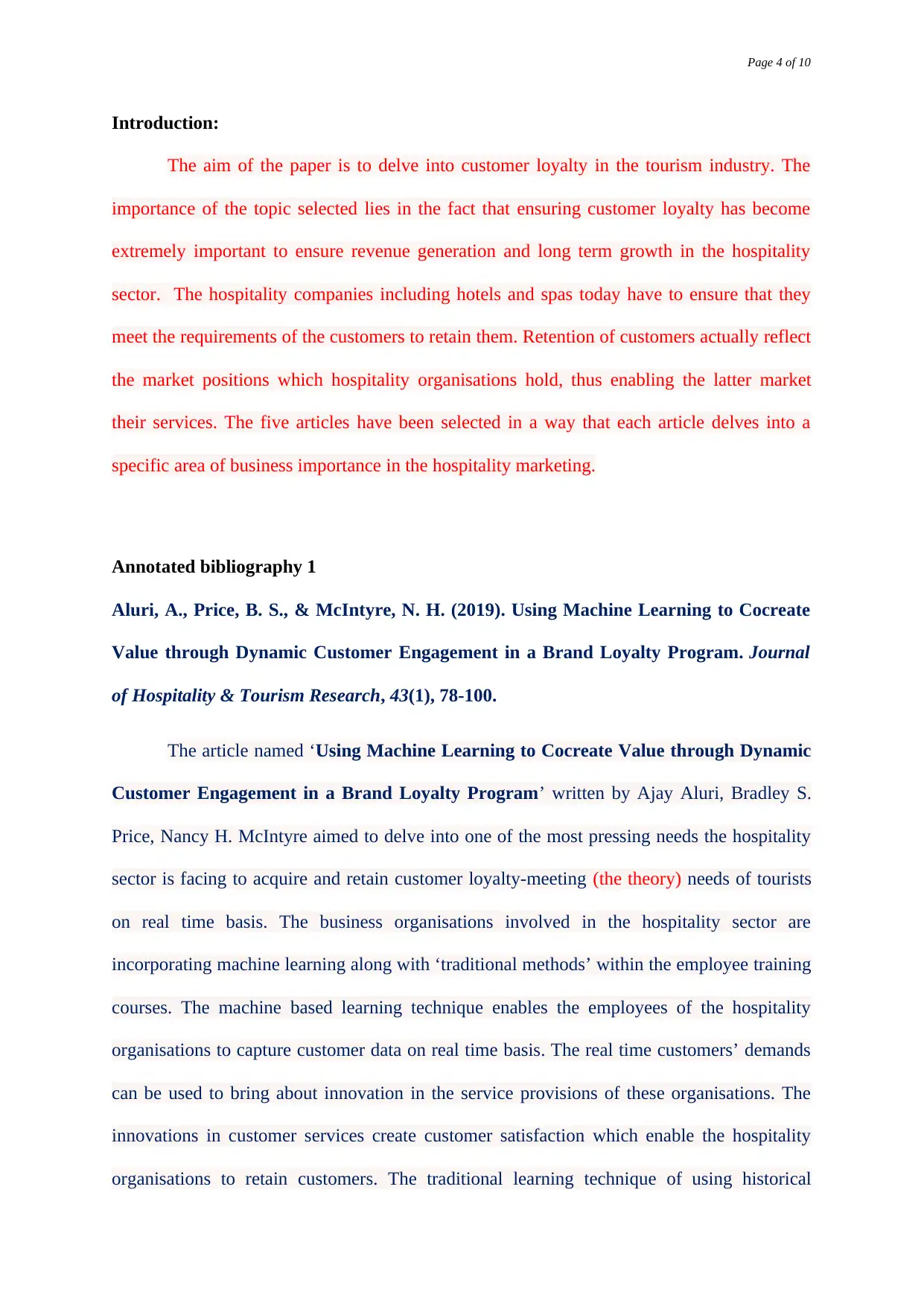
Page 4 of 10
Introduction:
The aim of the paper is to delve into customer loyalty in the tourism industry. The
importance of the topic selected lies in the fact that ensuring customer loyalty has become
extremely important to ensure revenue generation and long term growth in the hospitality
sector. The hospitality companies including hotels and spas today have to ensure that they
meet the requirements of the customers to retain them. Retention of customers actually reflect
the market positions which hospitality organisations hold, thus enabling the latter market
their services. The five articles have been selected in a way that each article delves into a
specific area of business importance in the hospitality marketing.
Annotated bibliography 1
Aluri, A., Price, B. S., & McIntyre, N. H. (2019). Using Machine Learning to Cocreate
Value through Dynamic Customer Engagement in a Brand Loyalty Program. Journal
of Hospitality & Tourism Research, 43(1), 78-100.
The article named ‘Using Machine Learning to Cocreate Value through Dynamic
Customer Engagement in a Brand Loyalty Program’ written by Ajay Aluri, Bradley S.
Price, Nancy H. McIntyre aimed to delve into one of the most pressing needs the hospitality
sector is facing to acquire and retain customer loyalty-meeting (the theory) needs of tourists
on real time basis. The business organisations involved in the hospitality sector are
incorporating machine learning along with ‘traditional methods’ within the employee training
courses. The machine based learning technique enables the employees of the hospitality
organisations to capture customer data on real time basis. The real time customers’ demands
can be used to bring about innovation in the service provisions of these organisations. The
innovations in customer services create customer satisfaction which enable the hospitality
organisations to retain customers. The traditional learning technique of using historical
Introduction:
The aim of the paper is to delve into customer loyalty in the tourism industry. The
importance of the topic selected lies in the fact that ensuring customer loyalty has become
extremely important to ensure revenue generation and long term growth in the hospitality
sector. The hospitality companies including hotels and spas today have to ensure that they
meet the requirements of the customers to retain them. Retention of customers actually reflect
the market positions which hospitality organisations hold, thus enabling the latter market
their services. The five articles have been selected in a way that each article delves into a
specific area of business importance in the hospitality marketing.
Annotated bibliography 1
Aluri, A., Price, B. S., & McIntyre, N. H. (2019). Using Machine Learning to Cocreate
Value through Dynamic Customer Engagement in a Brand Loyalty Program. Journal
of Hospitality & Tourism Research, 43(1), 78-100.
The article named ‘Using Machine Learning to Cocreate Value through Dynamic
Customer Engagement in a Brand Loyalty Program’ written by Ajay Aluri, Bradley S.
Price, Nancy H. McIntyre aimed to delve into one of the most pressing needs the hospitality
sector is facing to acquire and retain customer loyalty-meeting (the theory) needs of tourists
on real time basis. The business organisations involved in the hospitality sector are
incorporating machine learning along with ‘traditional methods’ within the employee training
courses. The machine based learning technique enables the employees of the hospitality
organisations to capture customer data on real time basis. The real time customers’ demands
can be used to bring about innovation in the service provisions of these organisations. The
innovations in customer services create customer satisfaction which enable the hospitality
organisations to retain customers. The traditional learning technique of using historical
Paraphrase This Document
Need a fresh take? Get an instant paraphrase of this document with our AI Paraphraser
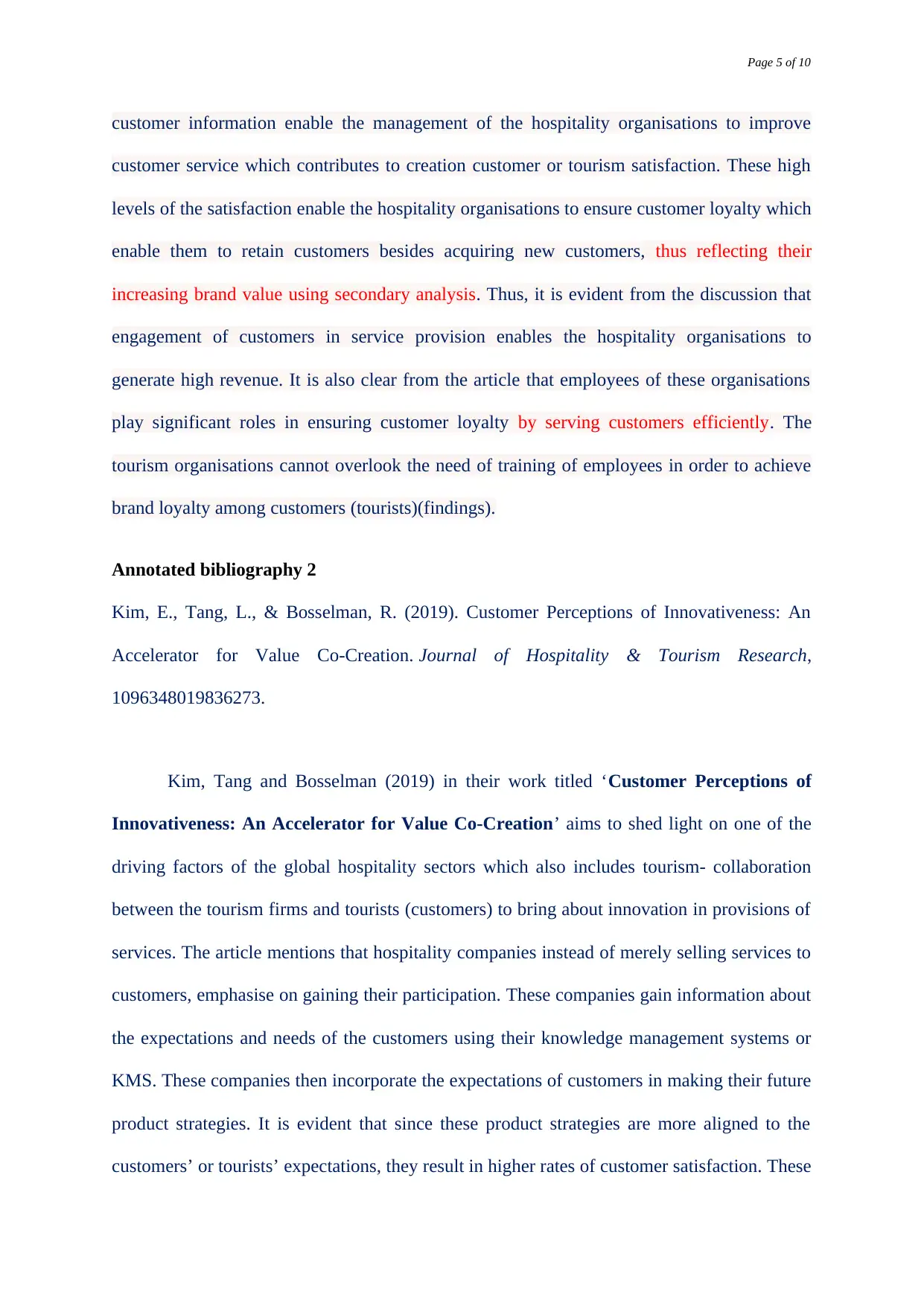
Page 5 of 10
customer information enable the management of the hospitality organisations to improve
customer service which contributes to creation customer or tourism satisfaction. These high
levels of the satisfaction enable the hospitality organisations to ensure customer loyalty which
enable them to retain customers besides acquiring new customers, thus reflecting their
increasing brand value using secondary analysis. Thus, it is evident from the discussion that
engagement of customers in service provision enables the hospitality organisations to
generate high revenue. It is also clear from the article that employees of these organisations
play significant roles in ensuring customer loyalty by serving customers efficiently. The
tourism organisations cannot overlook the need of training of employees in order to achieve
brand loyalty among customers (tourists)(findings).
Annotated bibliography 2
Kim, E., Tang, L., & Bosselman, R. (2019). Customer Perceptions of Innovativeness: An
Accelerator for Value Co-Creation. Journal of Hospitality & Tourism Research,
1096348019836273.
Kim, Tang and Bosselman (2019) in their work titled ‘Customer Perceptions of
Innovativeness: An Accelerator for Value Co-Creation’ aims to shed light on one of the
driving factors of the global hospitality sectors which also includes tourism- collaboration
between the tourism firms and tourists (customers) to bring about innovation in provisions of
services. The article mentions that hospitality companies instead of merely selling services to
customers, emphasise on gaining their participation. These companies gain information about
the expectations and needs of the customers using their knowledge management systems or
KMS. These companies then incorporate the expectations of customers in making their future
product strategies. It is evident that since these product strategies are more aligned to the
customers’ or tourists’ expectations, they result in higher rates of customer satisfaction. These
customer information enable the management of the hospitality organisations to improve
customer service which contributes to creation customer or tourism satisfaction. These high
levels of the satisfaction enable the hospitality organisations to ensure customer loyalty which
enable them to retain customers besides acquiring new customers, thus reflecting their
increasing brand value using secondary analysis. Thus, it is evident from the discussion that
engagement of customers in service provision enables the hospitality organisations to
generate high revenue. It is also clear from the article that employees of these organisations
play significant roles in ensuring customer loyalty by serving customers efficiently. The
tourism organisations cannot overlook the need of training of employees in order to achieve
brand loyalty among customers (tourists)(findings).
Annotated bibliography 2
Kim, E., Tang, L., & Bosselman, R. (2019). Customer Perceptions of Innovativeness: An
Accelerator for Value Co-Creation. Journal of Hospitality & Tourism Research,
1096348019836273.
Kim, Tang and Bosselman (2019) in their work titled ‘Customer Perceptions of
Innovativeness: An Accelerator for Value Co-Creation’ aims to shed light on one of the
driving factors of the global hospitality sectors which also includes tourism- collaboration
between the tourism firms and tourists (customers) to bring about innovation in provisions of
services. The article mentions that hospitality companies instead of merely selling services to
customers, emphasise on gaining their participation. These companies gain information about
the expectations and needs of the customers using their knowledge management systems or
KMS. These companies then incorporate the expectations of customers in making their future
product strategies. It is evident that since these product strategies are more aligned to the
customers’ or tourists’ expectations, they result in higher rates of customer satisfaction. These
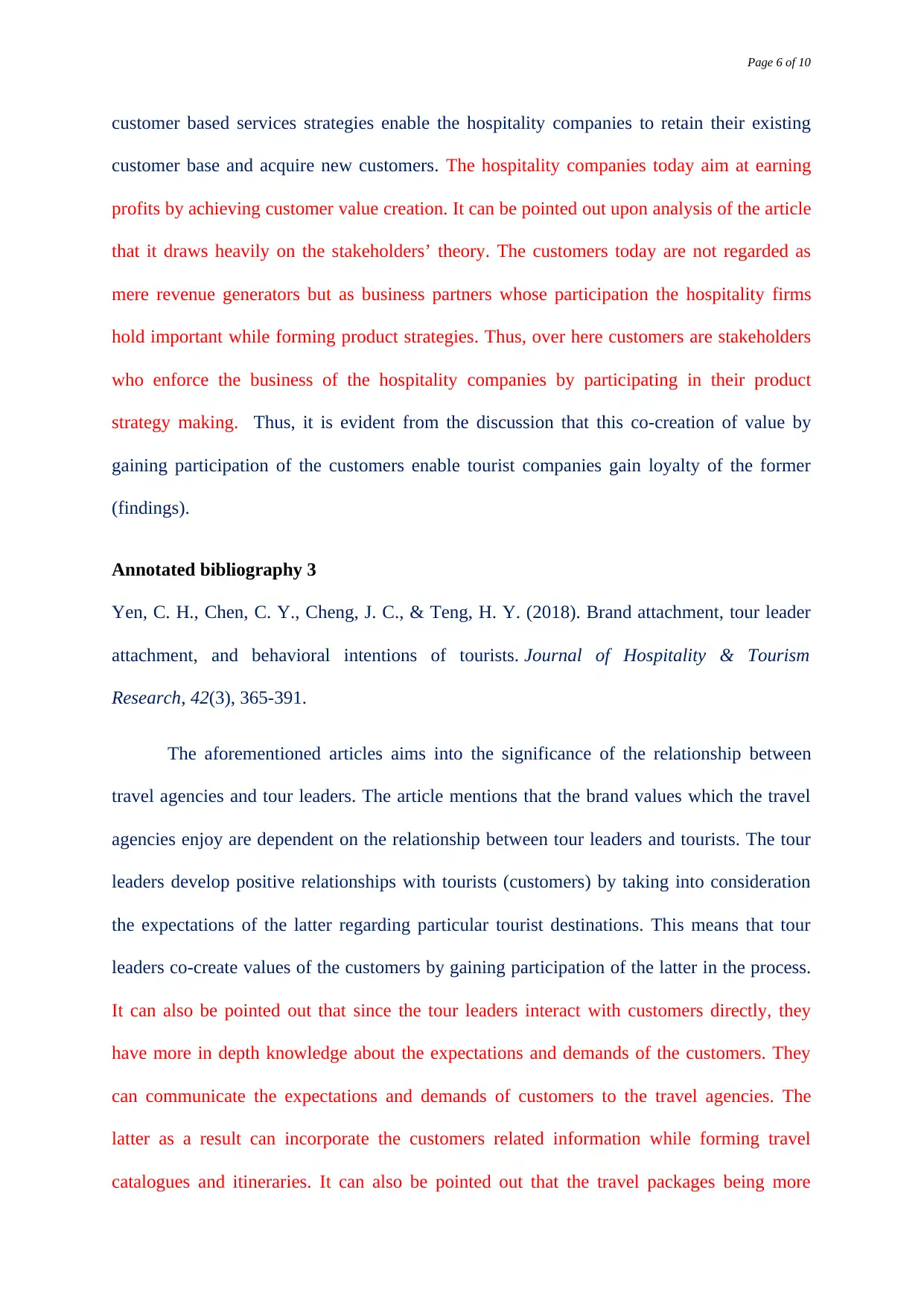
Page 6 of 10
customer based services strategies enable the hospitality companies to retain their existing
customer base and acquire new customers. The hospitality companies today aim at earning
profits by achieving customer value creation. It can be pointed out upon analysis of the article
that it draws heavily on the stakeholders’ theory. The customers today are not regarded as
mere revenue generators but as business partners whose participation the hospitality firms
hold important while forming product strategies. Thus, over here customers are stakeholders
who enforce the business of the hospitality companies by participating in their product
strategy making. Thus, it is evident from the discussion that this co-creation of value by
gaining participation of the customers enable tourist companies gain loyalty of the former
(findings).
Annotated bibliography 3
Yen, C. H., Chen, C. Y., Cheng, J. C., & Teng, H. Y. (2018). Brand attachment, tour leader
attachment, and behavioral intentions of tourists. Journal of Hospitality & Tourism
Research, 42(3), 365-391.
The aforementioned articles aims into the significance of the relationship between
travel agencies and tour leaders. The article mentions that the brand values which the travel
agencies enjoy are dependent on the relationship between tour leaders and tourists. The tour
leaders develop positive relationships with tourists (customers) by taking into consideration
the expectations of the latter regarding particular tourist destinations. This means that tour
leaders co-create values of the customers by gaining participation of the latter in the process.
It can also be pointed out that since the tour leaders interact with customers directly, they
have more in depth knowledge about the expectations and demands of the customers. They
can communicate the expectations and demands of customers to the travel agencies. The
latter as a result can incorporate the customers related information while forming travel
catalogues and itineraries. It can also be pointed out that the travel packages being more
customer based services strategies enable the hospitality companies to retain their existing
customer base and acquire new customers. The hospitality companies today aim at earning
profits by achieving customer value creation. It can be pointed out upon analysis of the article
that it draws heavily on the stakeholders’ theory. The customers today are not regarded as
mere revenue generators but as business partners whose participation the hospitality firms
hold important while forming product strategies. Thus, over here customers are stakeholders
who enforce the business of the hospitality companies by participating in their product
strategy making. Thus, it is evident from the discussion that this co-creation of value by
gaining participation of the customers enable tourist companies gain loyalty of the former
(findings).
Annotated bibliography 3
Yen, C. H., Chen, C. Y., Cheng, J. C., & Teng, H. Y. (2018). Brand attachment, tour leader
attachment, and behavioral intentions of tourists. Journal of Hospitality & Tourism
Research, 42(3), 365-391.
The aforementioned articles aims into the significance of the relationship between
travel agencies and tour leaders. The article mentions that the brand values which the travel
agencies enjoy are dependent on the relationship between tour leaders and tourists. The tour
leaders develop positive relationships with tourists (customers) by taking into consideration
the expectations of the latter regarding particular tourist destinations. This means that tour
leaders co-create values of the customers by gaining participation of the latter in the process.
It can also be pointed out that since the tour leaders interact with customers directly, they
have more in depth knowledge about the expectations and demands of the customers. They
can communicate the expectations and demands of customers to the travel agencies. The
latter as a result can incorporate the customers related information while forming travel
catalogues and itineraries. It can also be pointed out that the travel packages being more
⊘ This is a preview!⊘
Do you want full access?
Subscribe today to unlock all pages.

Trusted by 1+ million students worldwide
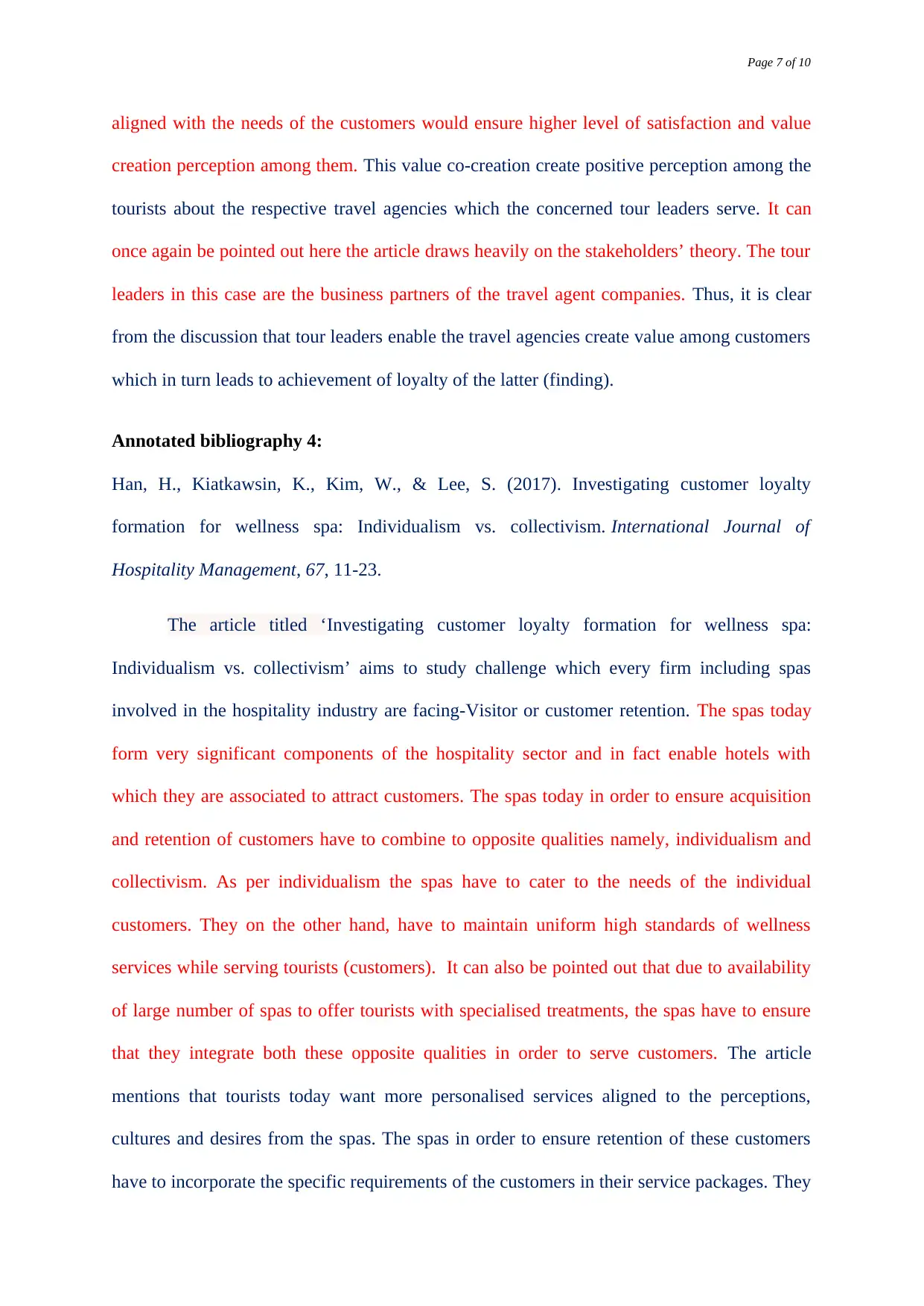
Page 7 of 10
aligned with the needs of the customers would ensure higher level of satisfaction and value
creation perception among them. This value co-creation create positive perception among the
tourists about the respective travel agencies which the concerned tour leaders serve. It can
once again be pointed out here the article draws heavily on the stakeholders’ theory. The tour
leaders in this case are the business partners of the travel agent companies. Thus, it is clear
from the discussion that tour leaders enable the travel agencies create value among customers
which in turn leads to achievement of loyalty of the latter (finding).
Annotated bibliography 4:
Han, H., Kiatkawsin, K., Kim, W., & Lee, S. (2017). Investigating customer loyalty
formation for wellness spa: Individualism vs. collectivism. International Journal of
Hospitality Management, 67, 11-23.
The article titled ‘Investigating customer loyalty formation for wellness spa:
Individualism vs. collectivism’ aims to study challenge which every firm including spas
involved in the hospitality industry are facing-Visitor or customer retention. The spas today
form very significant components of the hospitality sector and in fact enable hotels with
which they are associated to attract customers. The spas today in order to ensure acquisition
and retention of customers have to combine to opposite qualities namely, individualism and
collectivism. As per individualism the spas have to cater to the needs of the individual
customers. They on the other hand, have to maintain uniform high standards of wellness
services while serving tourists (customers). It can also be pointed out that due to availability
of large number of spas to offer tourists with specialised treatments, the spas have to ensure
that they integrate both these opposite qualities in order to serve customers. The article
mentions that tourists today want more personalised services aligned to the perceptions,
cultures and desires from the spas. The spas in order to ensure retention of these customers
have to incorporate the specific requirements of the customers in their service packages. They
aligned with the needs of the customers would ensure higher level of satisfaction and value
creation perception among them. This value co-creation create positive perception among the
tourists about the respective travel agencies which the concerned tour leaders serve. It can
once again be pointed out here the article draws heavily on the stakeholders’ theory. The tour
leaders in this case are the business partners of the travel agent companies. Thus, it is clear
from the discussion that tour leaders enable the travel agencies create value among customers
which in turn leads to achievement of loyalty of the latter (finding).
Annotated bibliography 4:
Han, H., Kiatkawsin, K., Kim, W., & Lee, S. (2017). Investigating customer loyalty
formation for wellness spa: Individualism vs. collectivism. International Journal of
Hospitality Management, 67, 11-23.
The article titled ‘Investigating customer loyalty formation for wellness spa:
Individualism vs. collectivism’ aims to study challenge which every firm including spas
involved in the hospitality industry are facing-Visitor or customer retention. The spas today
form very significant components of the hospitality sector and in fact enable hotels with
which they are associated to attract customers. The spas today in order to ensure acquisition
and retention of customers have to combine to opposite qualities namely, individualism and
collectivism. As per individualism the spas have to cater to the needs of the individual
customers. They on the other hand, have to maintain uniform high standards of wellness
services while serving tourists (customers). It can also be pointed out that due to availability
of large number of spas to offer tourists with specialised treatments, the spas have to ensure
that they integrate both these opposite qualities in order to serve customers. The article
mentions that tourists today want more personalised services aligned to the perceptions,
cultures and desires from the spas. The spas in order to ensure retention of these customers
have to incorporate the specific requirements of the customers in their service packages. They
Paraphrase This Document
Need a fresh take? Get an instant paraphrase of this document with our AI Paraphraser
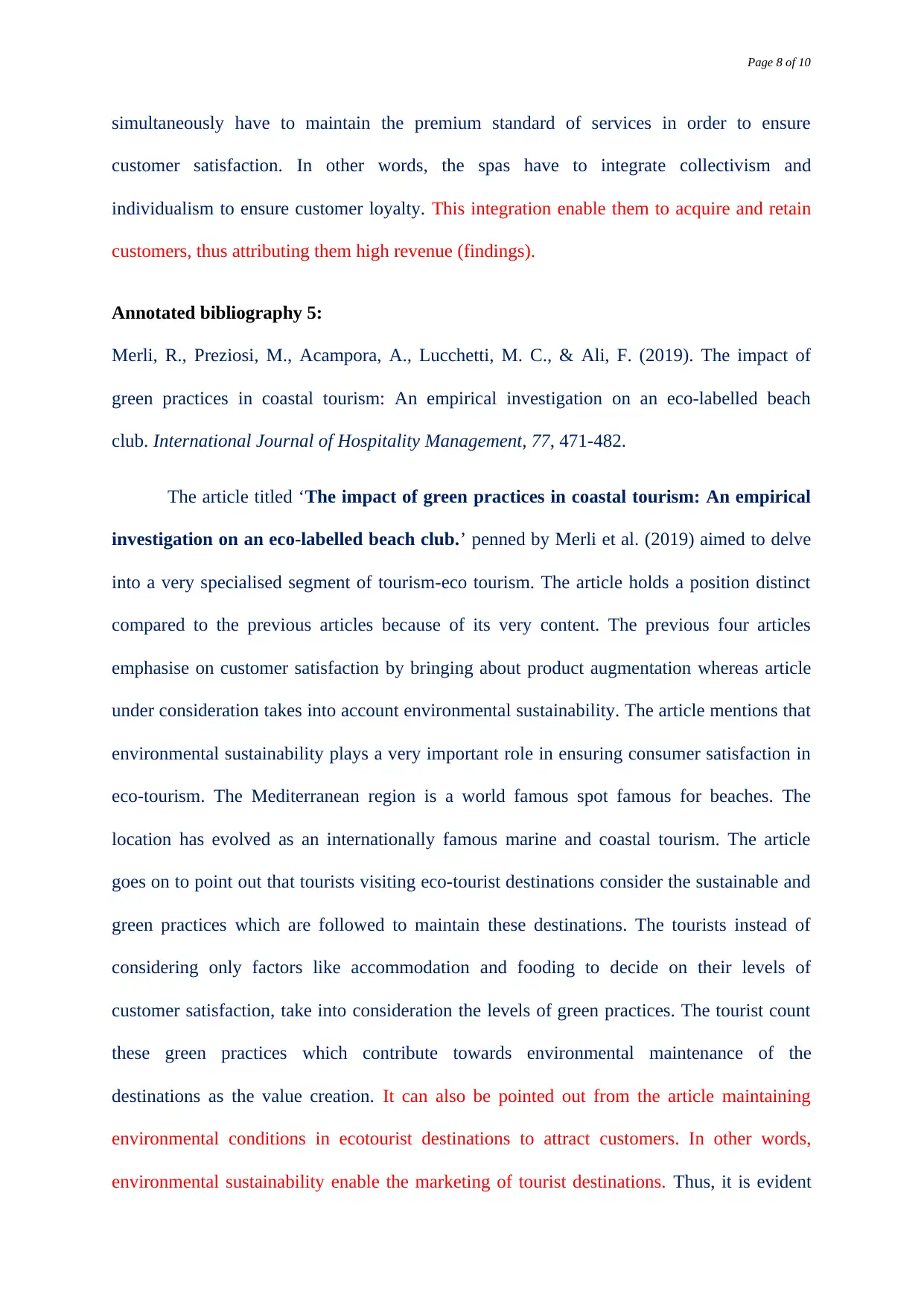
Page 8 of 10
simultaneously have to maintain the premium standard of services in order to ensure
customer satisfaction. In other words, the spas have to integrate collectivism and
individualism to ensure customer loyalty. This integration enable them to acquire and retain
customers, thus attributing them high revenue (findings).
Annotated bibliography 5:
Merli, R., Preziosi, M., Acampora, A., Lucchetti, M. C., & Ali, F. (2019). The impact of
green practices in coastal tourism: An empirical investigation on an eco-labelled beach
club. International Journal of Hospitality Management, 77, 471-482.
The article titled ‘The impact of green practices in coastal tourism: An empirical
investigation on an eco-labelled beach club.’ penned by Merli et al. (2019) aimed to delve
into a very specialised segment of tourism-eco tourism. The article holds a position distinct
compared to the previous articles because of its very content. The previous four articles
emphasise on customer satisfaction by bringing about product augmentation whereas article
under consideration takes into account environmental sustainability. The article mentions that
environmental sustainability plays a very important role in ensuring consumer satisfaction in
eco-tourism. The Mediterranean region is a world famous spot famous for beaches. The
location has evolved as an internationally famous marine and coastal tourism. The article
goes on to point out that tourists visiting eco-tourist destinations consider the sustainable and
green practices which are followed to maintain these destinations. The tourists instead of
considering only factors like accommodation and fooding to decide on their levels of
customer satisfaction, take into consideration the levels of green practices. The tourist count
these green practices which contribute towards environmental maintenance of the
destinations as the value creation. It can also be pointed out from the article maintaining
environmental conditions in ecotourist destinations to attract customers. In other words,
environmental sustainability enable the marketing of tourist destinations. Thus, it is evident
simultaneously have to maintain the premium standard of services in order to ensure
customer satisfaction. In other words, the spas have to integrate collectivism and
individualism to ensure customer loyalty. This integration enable them to acquire and retain
customers, thus attributing them high revenue (findings).
Annotated bibliography 5:
Merli, R., Preziosi, M., Acampora, A., Lucchetti, M. C., & Ali, F. (2019). The impact of
green practices in coastal tourism: An empirical investigation on an eco-labelled beach
club. International Journal of Hospitality Management, 77, 471-482.
The article titled ‘The impact of green practices in coastal tourism: An empirical
investigation on an eco-labelled beach club.’ penned by Merli et al. (2019) aimed to delve
into a very specialised segment of tourism-eco tourism. The article holds a position distinct
compared to the previous articles because of its very content. The previous four articles
emphasise on customer satisfaction by bringing about product augmentation whereas article
under consideration takes into account environmental sustainability. The article mentions that
environmental sustainability plays a very important role in ensuring consumer satisfaction in
eco-tourism. The Mediterranean region is a world famous spot famous for beaches. The
location has evolved as an internationally famous marine and coastal tourism. The article
goes on to point out that tourists visiting eco-tourist destinations consider the sustainable and
green practices which are followed to maintain these destinations. The tourists instead of
considering only factors like accommodation and fooding to decide on their levels of
customer satisfaction, take into consideration the levels of green practices. The tourist count
these green practices which contribute towards environmental maintenance of the
destinations as the value creation. It can also be pointed out from the article maintaining
environmental conditions in ecotourist destinations to attract customers. In other words,
environmental sustainability enable the marketing of tourist destinations. Thus, it is evident
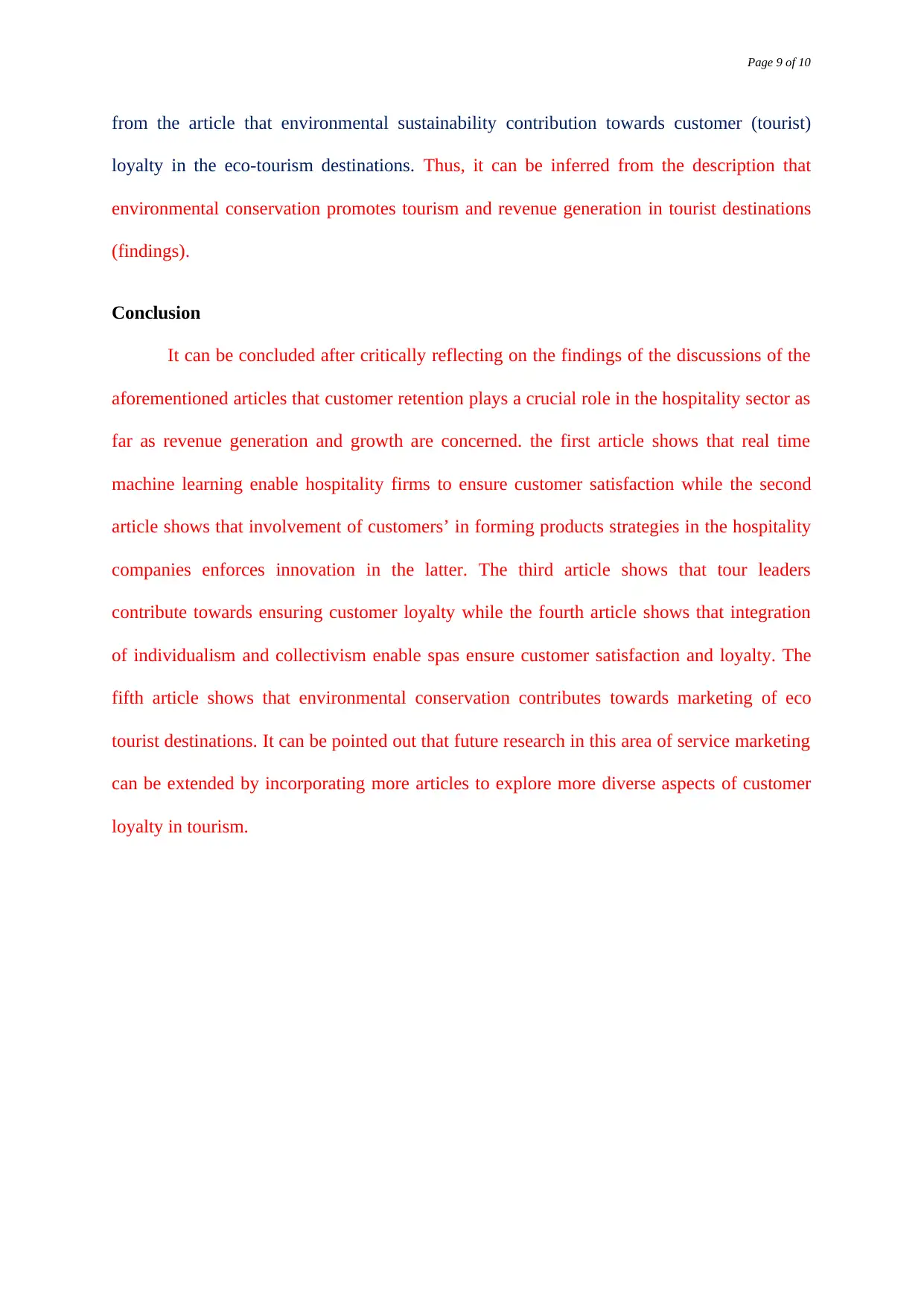
Page 9 of 10
from the article that environmental sustainability contribution towards customer (tourist)
loyalty in the eco-tourism destinations. Thus, it can be inferred from the description that
environmental conservation promotes tourism and revenue generation in tourist destinations
(findings).
Conclusion
It can be concluded after critically reflecting on the findings of the discussions of the
aforementioned articles that customer retention plays a crucial role in the hospitality sector as
far as revenue generation and growth are concerned. the first article shows that real time
machine learning enable hospitality firms to ensure customer satisfaction while the second
article shows that involvement of customers’ in forming products strategies in the hospitality
companies enforces innovation in the latter. The third article shows that tour leaders
contribute towards ensuring customer loyalty while the fourth article shows that integration
of individualism and collectivism enable spas ensure customer satisfaction and loyalty. The
fifth article shows that environmental conservation contributes towards marketing of eco
tourist destinations. It can be pointed out that future research in this area of service marketing
can be extended by incorporating more articles to explore more diverse aspects of customer
loyalty in tourism.
from the article that environmental sustainability contribution towards customer (tourist)
loyalty in the eco-tourism destinations. Thus, it can be inferred from the description that
environmental conservation promotes tourism and revenue generation in tourist destinations
(findings).
Conclusion
It can be concluded after critically reflecting on the findings of the discussions of the
aforementioned articles that customer retention plays a crucial role in the hospitality sector as
far as revenue generation and growth are concerned. the first article shows that real time
machine learning enable hospitality firms to ensure customer satisfaction while the second
article shows that involvement of customers’ in forming products strategies in the hospitality
companies enforces innovation in the latter. The third article shows that tour leaders
contribute towards ensuring customer loyalty while the fourth article shows that integration
of individualism and collectivism enable spas ensure customer satisfaction and loyalty. The
fifth article shows that environmental conservation contributes towards marketing of eco
tourist destinations. It can be pointed out that future research in this area of service marketing
can be extended by incorporating more articles to explore more diverse aspects of customer
loyalty in tourism.
⊘ This is a preview!⊘
Do you want full access?
Subscribe today to unlock all pages.

Trusted by 1+ million students worldwide
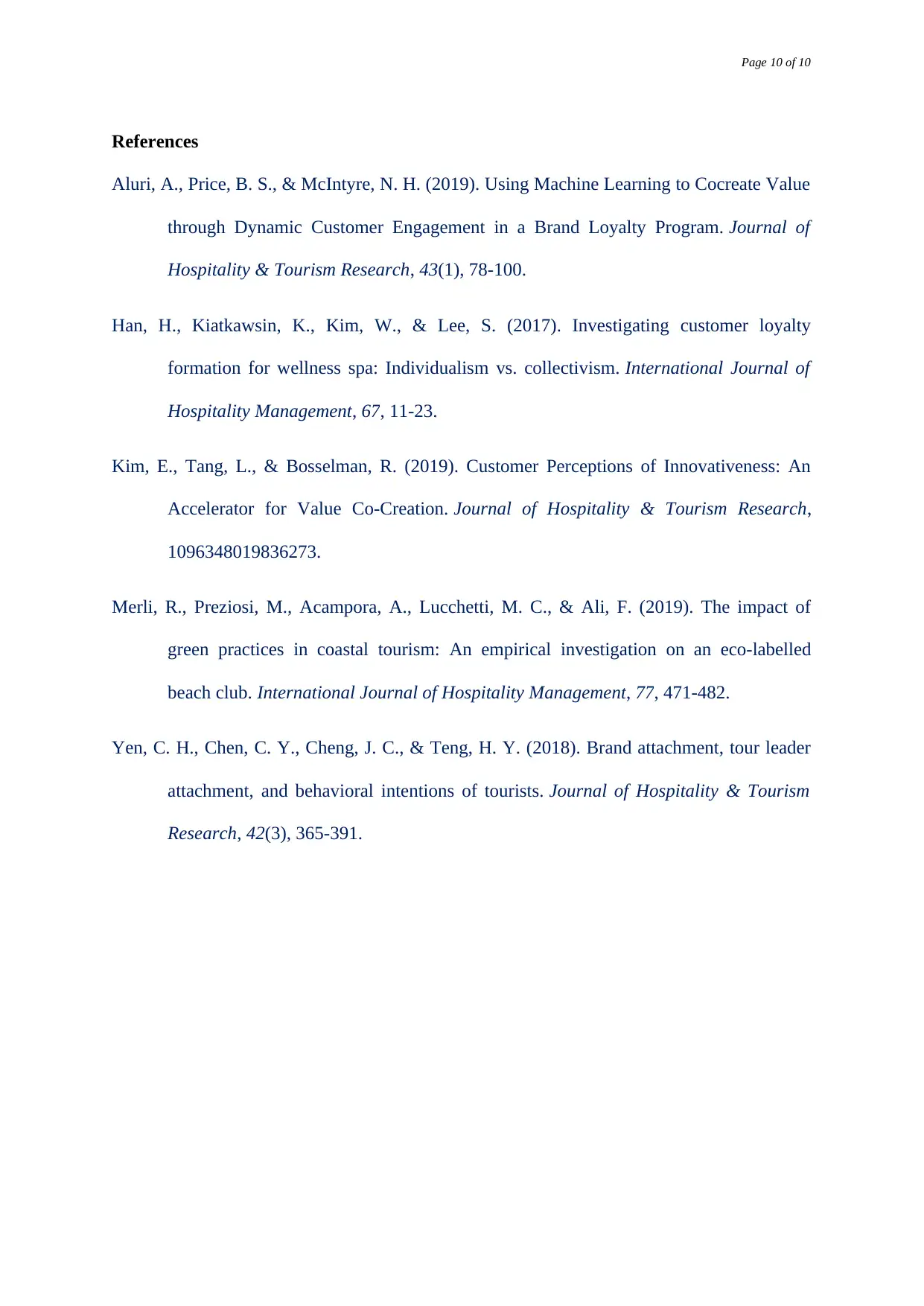
Page 10 of 10
References
Aluri, A., Price, B. S., & McIntyre, N. H. (2019). Using Machine Learning to Cocreate Value
through Dynamic Customer Engagement in a Brand Loyalty Program. Journal of
Hospitality & Tourism Research, 43(1), 78-100.
Han, H., Kiatkawsin, K., Kim, W., & Lee, S. (2017). Investigating customer loyalty
formation for wellness spa: Individualism vs. collectivism. International Journal of
Hospitality Management, 67, 11-23.
Kim, E., Tang, L., & Bosselman, R. (2019). Customer Perceptions of Innovativeness: An
Accelerator for Value Co-Creation. Journal of Hospitality & Tourism Research,
1096348019836273.
Merli, R., Preziosi, M., Acampora, A., Lucchetti, M. C., & Ali, F. (2019). The impact of
green practices in coastal tourism: An empirical investigation on an eco-labelled
beach club. International Journal of Hospitality Management, 77, 471-482.
Yen, C. H., Chen, C. Y., Cheng, J. C., & Teng, H. Y. (2018). Brand attachment, tour leader
attachment, and behavioral intentions of tourists. Journal of Hospitality & Tourism
Research, 42(3), 365-391.
References
Aluri, A., Price, B. S., & McIntyre, N. H. (2019). Using Machine Learning to Cocreate Value
through Dynamic Customer Engagement in a Brand Loyalty Program. Journal of
Hospitality & Tourism Research, 43(1), 78-100.
Han, H., Kiatkawsin, K., Kim, W., & Lee, S. (2017). Investigating customer loyalty
formation for wellness spa: Individualism vs. collectivism. International Journal of
Hospitality Management, 67, 11-23.
Kim, E., Tang, L., & Bosselman, R. (2019). Customer Perceptions of Innovativeness: An
Accelerator for Value Co-Creation. Journal of Hospitality & Tourism Research,
1096348019836273.
Merli, R., Preziosi, M., Acampora, A., Lucchetti, M. C., & Ali, F. (2019). The impact of
green practices in coastal tourism: An empirical investigation on an eco-labelled
beach club. International Journal of Hospitality Management, 77, 471-482.
Yen, C. H., Chen, C. Y., Cheng, J. C., & Teng, H. Y. (2018). Brand attachment, tour leader
attachment, and behavioral intentions of tourists. Journal of Hospitality & Tourism
Research, 42(3), 365-391.
1 out of 10
Your All-in-One AI-Powered Toolkit for Academic Success.
+13062052269
info@desklib.com
Available 24*7 on WhatsApp / Email
![[object Object]](/_next/static/media/star-bottom.7253800d.svg)
Unlock your academic potential
Copyright © 2020–2025 A2Z Services. All Rights Reserved. Developed and managed by ZUCOL.

